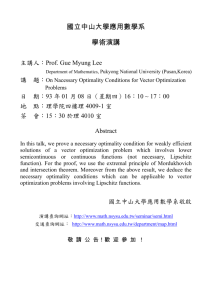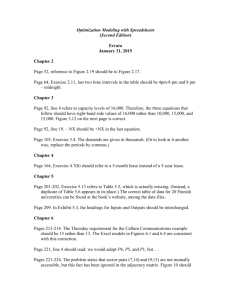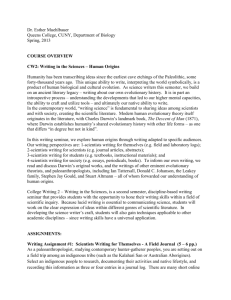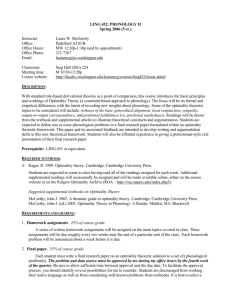Handout
advertisement
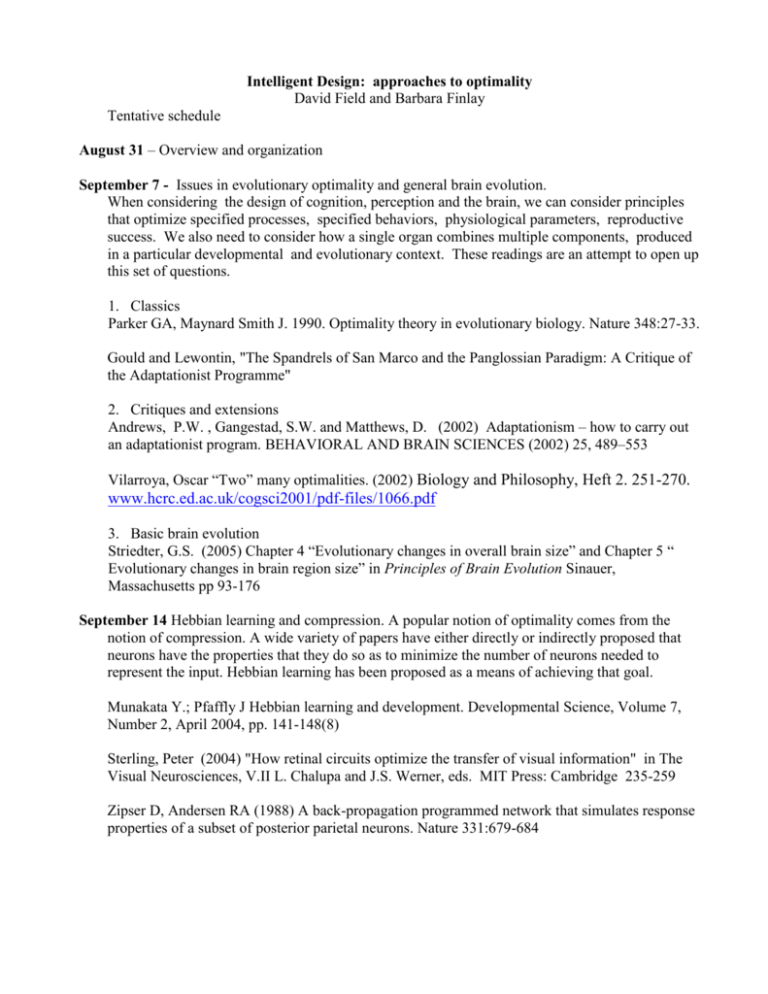
Intelligent Design: approaches to optimality David Field and Barbara Finlay Tentative schedule August 31 – Overview and organization September 7 - Issues in evolutionary optimality and general brain evolution. When considering the design of cognition, perception and the brain, we can consider principles that optimize specified processes, specified behaviors, physiological parameters, reproductive success. We also need to consider how a single organ combines multiple components, produced in a particular developmental and evolutionary context. These readings are an attempt to open up this set of questions. 1. Classics Parker GA, Maynard Smith J. 1990. Optimality theory in evolutionary biology. Nature 348:27-33. Gould and Lewontin, "The Spandrels of San Marco and the Panglossian Paradigm: A Critique of the Adaptationist Programme" 2. Critiques and extensions Andrews, P.W. , Gangestad, S.W. and Matthews, D. (2002) Adaptationism – how to carry out an adaptationist program. BEHAVIORAL AND BRAIN SCIENCES (2002) 25, 489–553 Vilarroya, Oscar “Two” many optimalities. (2002) Biology and Philosophy, Heft 2. 251-270. www.hcrc.ed.ac.uk/cogsci2001/pdf-files/1066.pdf 3. Basic brain evolution Striedter, G.S. (2005) Chapter 4 “Evolutionary changes in overall brain size” and Chapter 5 “ Evolutionary changes in brain region size” in Principles of Brain Evolution Sinauer, Massachusetts pp 93-176 September 14 Hebbian learning and compression. A popular notion of optimality comes from the notion of compression. A wide variety of papers have either directly or indirectly proposed that neurons have the properties that they do so as to minimize the number of neurons needed to represent the input. Hebbian learning has been proposed as a means of achieving that goal. Munakata Y.; Pfaffly J Hebbian learning and development. Developmental Science, Volume 7, Number 2, April 2004, pp. 141-148(8) Sterling, Peter (2004) "How retinal circuits optimize the transfer of visual information" in The Visual Neurosciences, V.II L. Chalupa and J.S. Werner, eds. MIT Press: Cambridge 235-259 Zipser D, Andersen RA (1988) A back-propagation programmed network that simulates response properties of a subset of posterior parietal neurons. Nature 331:679-684 September 21 Sparse coding, overcomplete codes etc (Field) Field, 1994 What is the Goal of Sensory Coding Simoncelli EP and Olshausen BA 2001 Natural image statistics and neural representation Ann. Rev. Neurosci. 24 1193-21 September 28 - Other definitions of optimality (Shimon, Florencia?) Language and time October 5 - Multiple constraint satisfaction in the retina Optimization for high resolution diurnal vision vs: Nocturnal vision Attention and orienting to movement Number and type of channels and cell types: chromatic, spatial and temporal. Generating the retina Finlay, B. L., Silveira, L.C.L. and Reichenbach, A. (2005) Comparative aspects of visual system development. In: The Structure, Function and Evolution of the Primate Visual System J. Kremers, ed. John Wiley and Sons pp. 37-72 Fernald, R.D. (2004). Eyes: Variety, development and evolution Brain, Behavior and Evolution 64: 141-147 253-259. October 12 – Fall Break (well , sort of) October 19 Optimality and color vision Primate visual system evolution: the interesting issue here is the path-like, ad hoc feel of the evolution of the primate eye, versus the principalled accounts of both optimality and adaptation. The best example is the sex-linked trichromacy of New World monkeys – the combination of photopigment “jitter” and foveal organization allows only females to be trichromats. Since “New World monkeys” comprises any number of animal size, food and canopy niches, there is no nonlaughable argument that could produce more pressure for trichromacy in females. The three intro chapters of the primate vision book would be nice to review. Martin, R.D. and Ross, C.F. The evolutionary and ecological context of primate vision. Hunt, D.M., Jacobs, G.H. and Bowmaker, J.K. The genetics and evolution of primate visual pigments Osorio, D., Vorobyev, M. and Jacobs, G.H. The ecology of the primate eye: retinal sampling and color vision. October 26 - Invariances: Are they really there, and what do they mean? Does a conserved feature of organization show you a “constraint” or is it a clue to an aspect of optimal design? Examples include 3/4 brain body scaling; constant rate of brain growth; allometric scaling of “life history” events. Nee, et al. (2005) The illusion of invariant quantities in life histories. Science 309 1236-1239 Passingham; basic allometry. November 2 Wiring up the cortex: maps, columns, slabs, blobs and the like. What sets it up? Why? How do we integrate in highly distributed stuff like the motor cortex being activated for word meanings involving actions to the localizationist account that the map and Hebbian-sorting tends to generate.? (Pulvermuller) My A&P article with Peter Brodsky has a lot on this issue. Zhang and Sejnowski, etc. November 9 Overcomplete codes and the brain body problem. Why does a big body make you stupid? November 16 Universal coding strategies? It is thought that major regions of the brain do particular types of analysis. Is there anything like an optimal code for the entire brain? We could also do a little bit on what the cell assembly is actually like in each one of the structures. Graybiel AM and Saka E (2004). The basal ganglia and the control of action. In: The New Cognitive Neurosciences, 3rd Ed., MS Gazzaniga, Ed. Cambridge, MA: MIT Press. pp 495-510 Attalah, H., Frank, M.J. & O'Reilly, R.C (2005). Hippocampus, cortex and basal ganglia: Insights from computational models of complementary learning systems. Neurobiology of Learning and Memory. Doya, K. 2001 Complementary roles of basal ganglia and cerebellum in learning and motor control. Current Opinion in Neurobiology 10:732-739. Shadlen, M.N. and Gold, J.I. The neurophysiology of decision making as a window on cognition In: The New Cognitive Neurosciences, 3rd Ed., MS Gazzaniga, Ed. Cambridge, MA: MIT Press. pp 1229-1241 Stuff 2. What should we do with lots of neurons? Overcomplete codes. You’re probably thinking of the excess cortex in large brained animals, which would be good to consider, but another interesting case is the chicken, with not much of a fovea, very little brain and 2 million optic nerve axons – about twice the human amount. There is psychophysics to indicate that chickens and pigeons do stuff locally and quite differently. 3. How do foveas and eye movements for foveations change the nature of visual system organization? Also, all the “save wire’ stuff 8. Brain to body ratio – sampling sensory surfaces: how do different sensory and motor systems need to scale? How to they interface
